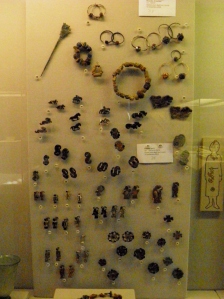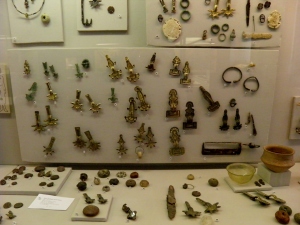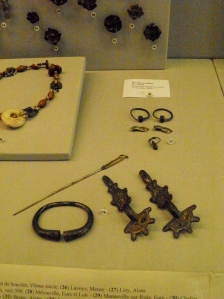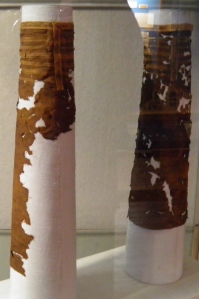Here is the description from a panel at the National Archaeological Museum, Saint Germain-en-Laye:
Merovingian women’s costume developed in the 2nd half of the 5th C, influenced by germanic styles, sometimes from the Danube region (large brooches and rectangular belt plaques). Around 500, in the thime of Clovis, a well-off Merovingian woman from the north of Gaul attached her over-dress with a pair of long bow brooches. this pair of bow brooches was worn in the area around the waist/belt and the hip. The brooches were worn with the head facing downwards. Extending downwards, at knee level, a pendant was often found: a large decorated or facetted glass bead, or one of jet, rock crystal or pyrite enclosed in a metallic mount; a deer antler medallion (made from the corona where the antler attaches to the deer’s head), a shell (possibly a cowrie shell), or other charms. The narrow belt would sometimes have a simple buckle. The top of the clothing (or possibly the veil) is attached at neck or chest height with a smaller pair of brooches. They could either be round with garnet cloissoné, or in the form of a bird, animal or S. The hair or the veil was sometimes held in place with a pin. Multicoloured glass and amber beads were used in necklaces and bracelets. Some of these beads were sewn to clothing. The most common earrings were open rings with one end decorated in a cube that might be decorated with garnets. In the 6th C, metal rings and bracelets were rare. These jewels were found on the left hand of rich Merovingian women. The number and nature of objects found signified important social differences in the graves of both men and women.
This was the first display case, with the large bow brooches and rectangular buckles below, and necklace beads and coins from the reign of Valentinian III (424-255) above.
Earrings at the top, then some bracelets and many small brooches in animal, S, bird and round shapes.
A collection of bow brooches from the end of the 5th and 6th C. On the right are a ring and two silver bracelets above a belt buckle. On the bottom left is a chopper or cleaver with its ferrule (a domestic implement often placed in the graves of wealthy Merovingian women). This one is from Oyes, Marne, in the 6th C. Just above the chopper is a pair of charms for hanging off a belt. The one on the left is a miniature curved knife or scythe, and the one on the right is a spoon.
These objects were all found in a rich childs grave from the late 5th C grave, in d’Oyes. It was excavated in the 19th C and some items have disappeared.
The necklace is from around 500, and the earrings, two small brooches and bead are from a late 5th C grave. The large brooches, bracelet and pin are from another late 5th C grave at the same site (d’Arcy, Sainte-Restitue, Aisne).
A collection of 6th C garnet brooches from Chelles, Ardennes, and Somme. The provenance of some is unknown.
A collection of the 5th-6th C pendant beads that hung down from the belt, plus a pair of brooches and a large bead from a grave from around 500, and an enammeled bow brooch in the shape of a bird from around 500.
Three sets of grave finds from Lavoye, Meuse. The first two are from around 500, and the third is from the first quarter of the 6th C. Note the two round pendants made of deer antler (bottom left and almost at the bottom on the right).
The glass, earthenware cup, beads and four brooches are all from a grave in d’Arcy Sainte Restitue, Aisne at the beginning of the 6th C. The bottle and four brooches on the left are from a grave c 500, in Oyes, Marne. The two hairpins are from the second half of the 6th C or 7th C. The one to the left is from Breny, Aisne, and the one on the right is from Armentieres, Aisne.
From a grave in Breny, Aisne, 2nd half of 6th C. There is what appears to be a key, a bow brooch, a pendant or charm, and a round garnet brooch.





































































